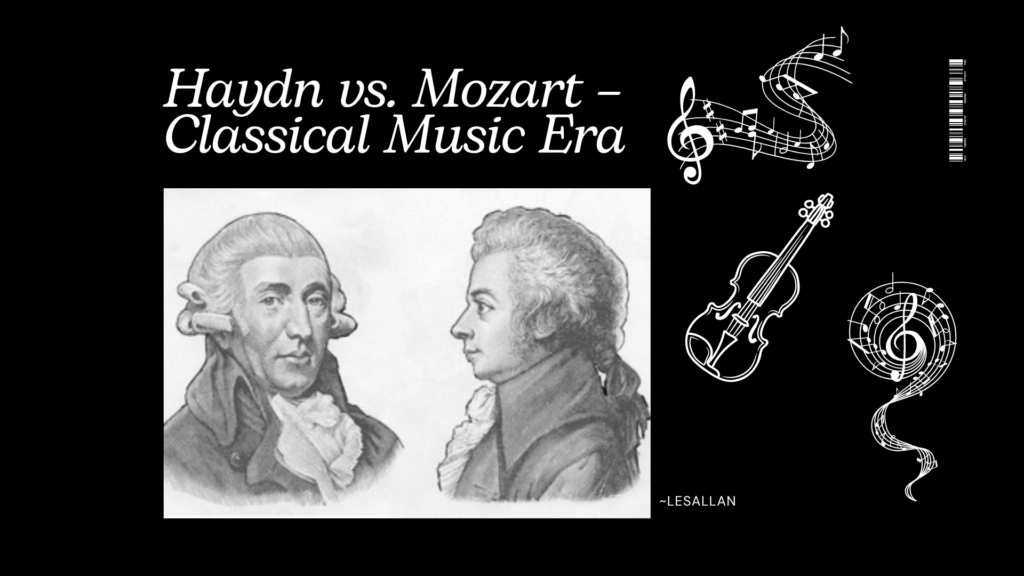
Written By Lesallan
FNA1000 Fine Arts Appreciation (ONAA58)
Ohio Christian University
Dr. Brent Nolte
June 2, 2023

Haydn vs. Mozart – Classical Music Era
The Classical era of Western art music spanned from around 1730 to 1830, succeeding the Baroque era and preceding the Romantic era. This era is marked by the balanced eclecticism of renowned composers such as Haydn, Mozart, and Beethoven, who revolutionized the textures and forms of music from the eighteenth century. Compared to Baroque music, Classical music is characterized by its lighter and clearer texture and its elegant and stylized forms.
Haydn significantly contributed to various classical music genres, such as Symphony, String Quartet, Piano Trio, Piano Sonata, Solo Concerto, Secular Mass, and Oratorio. He is notably recognized for his contributions to developing the string quartet and advancing the sonata form. Mozart’s musical prowess was unparalleled as he composed extensively in almost every genre of his era. His legacy is defined by his significant impact on opera and his pioneering work in piano concerto development. Beethoven’s music bridged the gap between the Classical and Romantic periods. He took the Classical form to new expressive heights during his early years by expanding on the musical language created by Mozart and Haydn in areas like structure, harmony, and form (Forney et al., 2021).
Haydn and Mozart were two notable composers of the Classical era, with similar musical styles in their works. However, their personal lives were remarkably different. Haydn earned the titles of “father of the symphony” and “father of the string quartet” (Hsieh, MingChih., 2021) for his significant contributions to developing these musical forms. Meanwhile, Mozart was renowned for his operas and skill in creating intricate and beautiful music.
The Italian comic opera tradition influenced both composers, but there are noticeable differences in their musical styles. For example, Mozart’s works are more vocal-centric, while Haydn’ are more grounded in instrumental music. In addition, Haydn often incorporates melodies from the Middle European folk tradition, whereas Mozart’s compositions are less influenced by folk music. Finally, regarding their personalities, Haydn has been described as deliberate, kind, bright, and level-headed, whereas Mozart is known for being sensitive, lively, confident, and easily influenced.
Two renowned composers of the classical period were Haydn and Mozart. Haydn was born in 1732, while Mozart was born in 1756. Haydn had a prolific career in which he composed over 100 symphonies, 83 string quartets, and numerous other works. “Haydn was the most celebrated musical figure in Europe during the Enlightenment. In an age that prized logic, emotional restraint, and reason, he shaped new musical ideas more than anyone” (Oregonian/OregonLive, 2009).
Similarly, Mozart was a prolific composer, producing over 600 works. Interestingly, both composers were employed by the Esterházy family at some point during their careers. Haydn’s compositions were acclaimed for their humor and wit, and he frequently incorporated folk music into his pieces. In contrast, thanks to his clever use of melody and harmony, Mozart’s music was renowned for its beauty and elegance.
Two renowned composers, Haydn and Mozart of the Classical era (1730-1820), helped pave the way for the introduction of the Romantic era. Both were born into families with strong musical backgrounds, and they each created works that combined various forms with sonata structures. Their contributions reformed and advanced classical music during the 18th century, as they developed innovative styles such as sympathy, opera, and concerto (Sim, H., 2014).
Haydn, a renowned composer, is known for his exceptional musical abilities, being Mozart’s mentor and musical influence. Both composers have created religious music, but Haydn’s deep faith is evident in all his works, as he believed that music should serve the dual purpose of praising God and uplifting humanity.
On the other hand, Mozart was not as religious as Haydn, but both were members of the same Masonic lodge in Vienna, where they became close friends and mutual admirers (Tarloff, 2007). Although they did not adhere to any specific religious or political beliefs, both composers were motivated by the values of compassion, assisting those in need, and honesty.
References:
Forney, K., Dell’Antonio, A., & Machlis, J. (2021). The enjoyment of music. W. W. Norton & Company.
Hsieh, MingChih. (2021). Piano Works of Franz Joseph Haydn: Analytical Views in Style and Structure. 10.2991/assehr.k.210519.052.
Oregonian/OregonLive, D. S. | S. to T. (2009, August 10). Haydn vs. Mozart: the battle of the classical composers. Oregonlive. https://www.oregonlive.com/O/2009/08/haydn_vs_mozart_the_battle_of.html
Sim, H. (2014, November 10). Haydn vs. Mozart. Prezi.com. https://prezi.com/tma-crnaoi1d/haydn-vs-mozart/
Tarloff, E. (2007, October 23). How to listen to Haydn and Mozart. Slate Magazine; Slate. https://slate.com/culture/2007/10/how-to-listen-to-haydn-and-mozart.html


